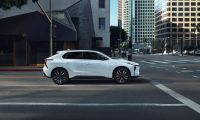Tesla PowerWall
Tesla offers a PowerWall, a backup battery storage product that allows a home to store Energy for use whenever it is needed - usually for a power outage. Tesla is now offering this product for sale by itself, and this has big implications. Let's go over what PowerWall does and then talk about what the implications are.
Each PowerWall unit has about 13.5 kWh of Energy that it can store, along with software that allows it to pull in Energy and transfer energy out. It's not just a bunch of batteries in a box - there is sophisticated software that manages the energy in it.
PowerWall can be used with solar panels to have energy from the sun transferred to batteries and then to have backup energy in case the energy grid goes out. Other uses for it include filling up the PowerWall during off-peak energy hours and using the PowerWall during peak energy hours.
PowerWalls can be installed in a garage or in a condo or apartment, though if you are renting, you will need permission from the landlord. I live in a condo that I have purchased and pay a mortgage on, so I'm curious what I would need to do to have a PowerWall installed.
Here are the exact Specs of the PowerWall:
* 13.5 kWh energy capacity
* On-Grid Power: 7.6 kVA/ 5.8 kVa continuous
* Backup Power: 9.6 kW / 7 kW continuous; 22 kW / 10 kW peak; 118A max LRA start and seamless backup transition
* Size and weight (LxWxH): 62.8 in x 29.7 in x 6.3 in; 343.9 lbs.
You may also be interested in:
- Like a Giant Sports Car - the Tesla Model X Plaid.
- How Much Can the Cybertruck Tow and What Range Will Be Lost?
- The staggering economics of the Tesla semi.
Why Buying It Separately Matters
There are major implications that come with Tesla's PowerWall being sold separately. Here are the implications, and we'll go over them one by one.
1: Owners can charge PowerWalls at night for a low cost and use the energy during peak hours for much lower electricity costs
2: Owners can charge PowerWalls at night and then give energy back to the grid to make money
3: Owners will have backup energy for use in case the grid goes out
4: The cost of a PowerWall will go down over time, especially with LFP batteries
First, owners will be able to charge PowerWall units at night when electricity is cheap. Then, during the day, when electricity is expensive, they can draw power from the PowerWall instead. This will cost much less and reduce electricity bills. My electricity bills are particularly expensive in the summer, well in excess of $100 per month.
Next, owners can charge their PowerWall units at night and then give energy back to the grid during the day when electricity is expensive. What is interesting about this is will it be more profitable to do this, or will it be more profitable to save money on electricity by using the PowerWall during peak hours. It probably depends on how much energy you use during the day.
Owners having backup energy to use in case the grid goes out is very important. For most people, having 3 PowerWall units should give enough energy for a few days if that household cuts back on their energy usage during the power outage. The typical household uses about 29 kWh per day.
The cost of the PowerWall needs to and will go down over time, especially as batteries go down in cost. In fact, you can look at the 13.5 kWh unit and calculate a rough cost of the batteries alone. 13.5 * $130 = $1,755. The cost of one PowerWall is $9,200.
That means you have an excess cost of $9,200 - $1,755 = $7,445. That extra cost goes to labor, other material costs to build the PowerWall besides the battery, the software that runs the PowerWall, and then the profit that Tesla makes.
I don't think the PowerWall is economical for most households yet - it's still an upper middle class or higher item. The cost of a PowerWall needs to get down to $2,000 per unit or less in order to be affordable to most households. That's not likely to happen for a while, though. Most households will get by with 2 of them for their energy needs.
I look forward to the day that batteries and solar are so inexpensive that they are ubiquitous to the world and available even to 3rd world countries. Energy should be so simple to get for anyone...
Would you get a Tesla PowerWall? Is it too expensive right now?
In Related News: Tesla Model Y is Big Savings For Police Departments
Leave your comments below, share the article with friends and tweet it out to your followers.
Jeremy Johnson is a Tesla investor and supporter. He first invested in Tesla in 2017 after years of following Elon Musk and admiring his work ethic and intelligence. Since then, he's become a Tesla bull, covering anything about Tesla he can find, while also dabbling in other electric vehicle companies. Jeremy covers Tesla developments at Torque News. You can follow him on Twitter or LinkedIn to stay in touch and follow his Tesla news coverage on Torque News.











